

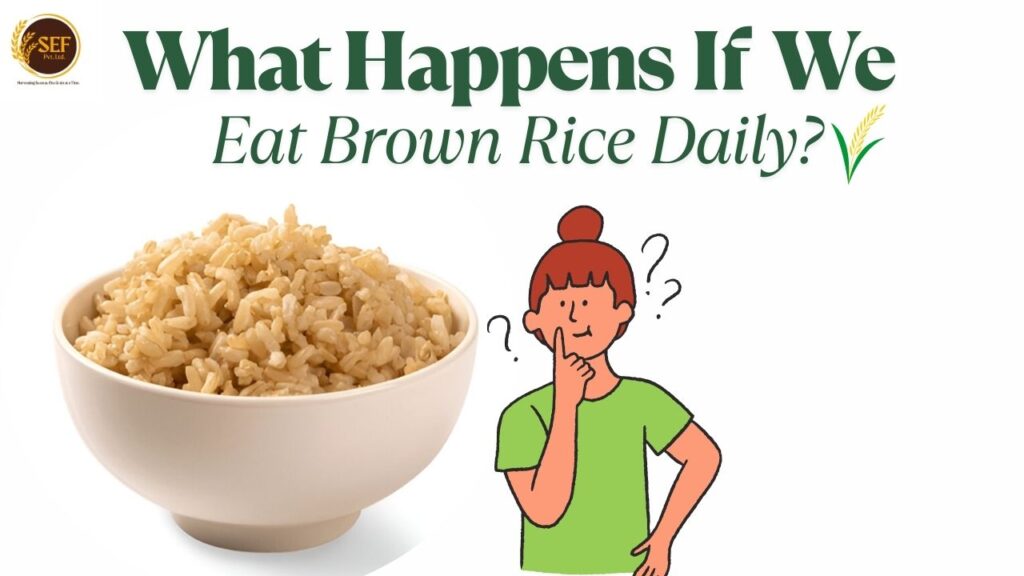
Brown rice is often regarded as one of the healthiest grains because of its high nutritional value, rich fiber content, and numerous health benefits. Unlike white rice, brown rice retains its bran and germ, making it a whole grain that’s packed with essential nutrients. In addition, it is often referred to as the best rice for health by nutritionists and fitness experts. But what happens if we eat brown rice every day? In this blog, we’ll explore the health benefits, potential side effects, and nutritional information to help you decide whether it should be a regular part of your diet.
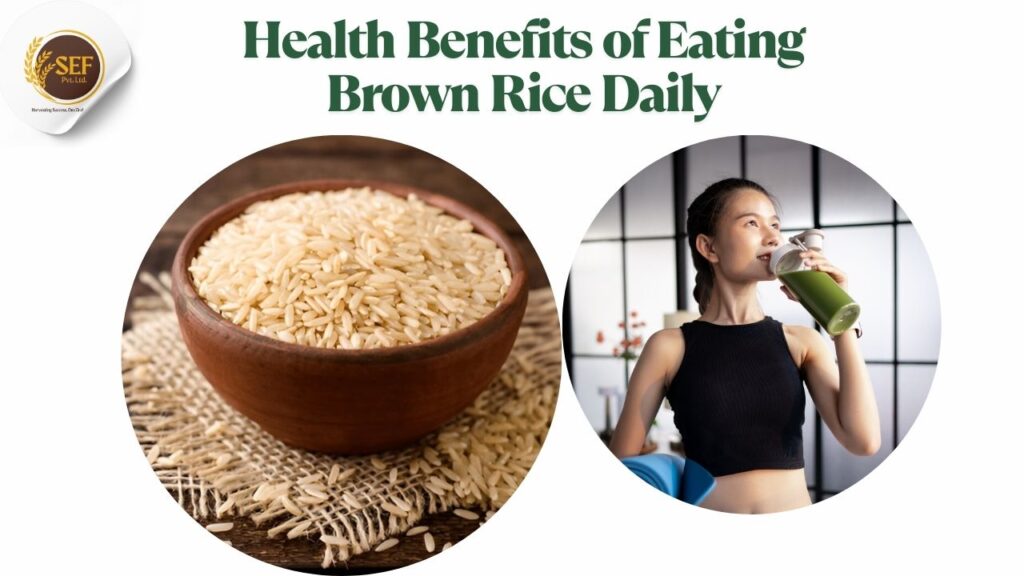
Brown rice offers a wide range of health benefits due to its high fiber content, antioxidants, and essential minerals. Moreover, here’s a breakdown of the health benefits of eating brown rice daily and why it’s so beneficial for your health:
Brown rice is an excellent source of dietary fiber, which aids in digestion and promotes regular bowel movements. Further, fiber contributes to lowering cholesterol levels, thereby reducing the risk of heart disease. Since fiber slows the digestion of carbohydrates, brown rice also helps control blood sugar levels and reduce insulin spikes, making it an excellent choice for people with diabetes.
Brown rice contains a variety of antioxidants, including lignans and phenols, which help protect the body from oxidative stress and inflammation. These antioxidants reduce the risk of chronic diseases such as cancer, heart disease, and diabetes. As a result, brown rice can reduce inflammation as well as promote overall health.
Brown rice has a low glycemic index (GI), which means it releases glucose into the bloodstream slowly, preventing sudden spikes in blood sugar. Additionally, brown rice’s steady release of energy makes it ideal for people who have diabetes or want to regulate their blood sugar levels.
Brown rice is a powerhouse of essential nutrients such as B vitamins, magnesium, manganese, selenium, and phosphorus. These vitamins and minerals support various bodily functions, including energy production, metabolism, bone health, and immune system function.
Consuming brown rice regularly may help reduce the risk of cardiovascular disease by improving blood pressure and lowering LDL cholesterol (the “bad” cholesterol). The fiber and antioxidants in brown rice work together to protect the heart and promote overall cardiovascular health.
Looking for premium brown rice? Contact Shah Enterprises today for bulk orders at competitive prices.
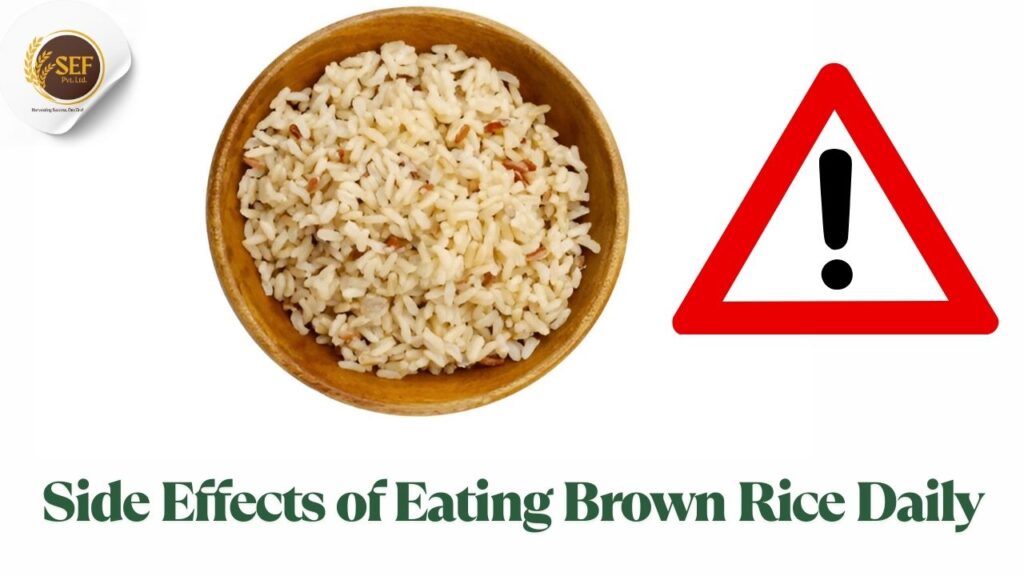
Although brown rice is incredibly healthy, consuming it daily without variation could lead to some potential issues. Here are the side effects of eating brown rice daily that you should keep in mind:
One of the primary concerns with brown rice is its higher arsenic content compared to white rice. Arsenic, a toxic element, accumulates in the bran layer, which is retained in brown rice. Moreover, long-term exposure to high levels of arsenic can result in various health problems, including cancer and heart disease. To reduce arsenic exposure, rinse brown rice thoroughly before cooking and cook it with excess water, which should be drained after cooking.
The high fiber content in brown rice can cause digestive discomfort for some individuals, especially those with sensitive stomachs or conditions like Irritable Bowel Syndrome (IBS). It’s best to introduce brown rice gradually into your diet to allow your digestive system to adjust to the increased fiber intake.
Brown rice contains phytic acid, which is an anti-nutrient that can bind essential minerals like iron and zinc, reducing their absorption. Furthermore, this may be problematic for individuals who have mineral deficiencies. To minimize this issue, soak brown rice before cooking to reduce the phytic acid content and improve mineral absorption.

Yes, brown rice good for weight loss when consumed in moderation. It’s a low-calorie, nutrient-dense food that provides bulk without excessive calories, making it a great option for those looking to control their weight.
Compared to processed foods, brown rice is low in calories and fat while offering a satisfying portion. Its high fiber content helps you feel full longer, reducing cravings and preventing overeating.
The fiber in brown rice promotes satiety, helping you feel satisfied after meals and reducing the temptation to snack in between. This helps control your overall food intake, contributing to weight management.
The low glycemic index of brown rice prevents insulin spikes and helps regulate blood sugar levels. This not only prevents fat storage but also reduces hunger cravings, which supports weight loss.
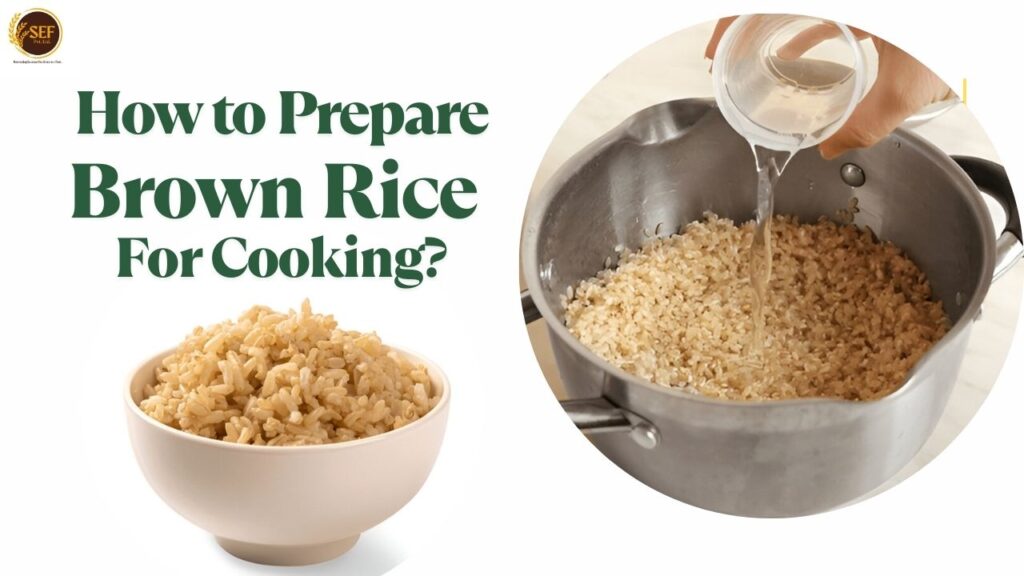
To get the most from your brown rice, both in nutrition and taste follow this preparation method:
Wash the rice 2-3 times to remove surface starch and any residual contaminants.
Soak for at least 30 minutes (or up to 4 hours) to reduce cooking time and improve digestibility.
Use 2.5 cups of water for every 1 cup of brown rice.
Bring water and rice to a boil, then reduce to a simmer and cover. Cook for about 40-45 minutes.
After cooking, let it sit for 10 minutes before fluffing with a fork.
Calorie content can vary slightly depending on the brand and preparation method. Here’s an average breakdown:
Compared to white rice, brown rice has slightly fewer calories and more nutrients, making it a healthier choice for daily consumption.
Have questions about brown rice? Chat with our experts or request a quote now!
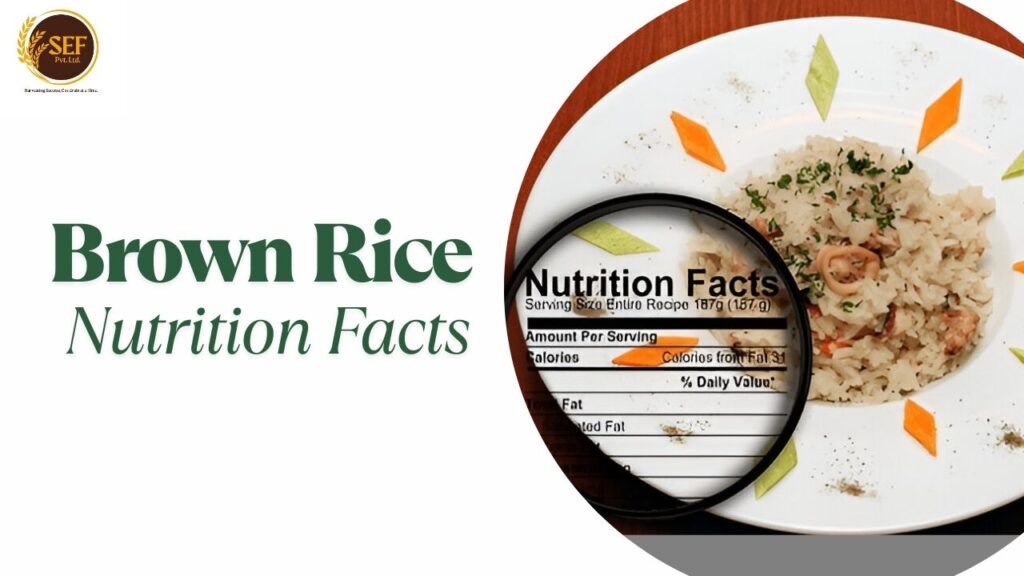
Here’s a quick look at the average nutritional content of 100 grams of cooked brown rice:
| Nutrient | Amount |
|---|---|
| Calories | 110-120 kcal |
| Carbohydrates | 23g |
| Protein | 2.5-3g |
| Fat | 0.9g |
| Dietary Fiber | 1.6g |
| Iron | 0.4 mg |
| Magnesium | 39 mg |
| Phosphorus | 83 mg |
| Manganese | 0.9 mg |
| Vitamin B6 | 0.1 mg |
These nutrients contribute to better metabolism, bone health, and overall vitality.
Despite being a healthier alternative to white rice, there are a few disadvantages to be mindful of:
Takes Longer to Cook: It can be less convenient for quick meals.
Harder Texture: Some people prefer the softer texture of white rice.
Higher Arsenic Levels: Long-term consumption of large amounts may increase exposure risk.
May Interfere With Mineral Absorption: Due to its phytic acid content.
To minimize these drawbacks, balance brown rice with other whole grains such as quinoa, millet, or oats, and vary your diet.
So, what happens if we eat brown rice daily? The answer depends on how it’s integrated into your overall diet. Further, when eaten in moderate amounts as part of a diverse and balanced meal plan, brown rice can offer impressive health benefits, including weight loss, heart health, and improved digestion. While it differs from eating raw rice benefits, which are minimal and often risky, brown rice provides a much safer and more nutritious alternative. However, overconsumption without variety may lead to unintended side effects such as digestive discomfort or reduced mineral absorption.
For best results, pair brown rice with a wide range of vegetables, proteins, and other whole grains. And don’t forget proper preparation techniques to reduce any potential risks.
At Shah Enterprises, we offer premium-quality brown rice sourced directly from trusted farms, ensuring purity, nutrition, and long-term health benefits in every grain.
A healthy adult can eat ½ to 1 cup of cooked brown rice per day, depending on calorie needs and activity level. It’s best to include it as part of a balanced diet with vegetables and protein.
Yes, brown rice is rich in antioxidants, B vitamins, and magnesium—all of which support skin repair, reduce inflammation, and promote a healthy glow from within.
Lunch is generally the best time to eat brown rice. It gives your body enough time to digest its complex carbs and use the energy throughout the day.
Yes, brown rice contains nutrients like zinc, iron, and B-complex vitamins that are essential for healthy hair growth and strengthening hair follicles.
Absolutely. Brown rice provides complex carbohydrates, magnesium, and fiber that help ease cramps, stabilize mood, and boost energy during menstruation.
Eating brown rice daily in moderation is healthy. It supports digestion, heart health, and weight management. However, rotating it with other grains can help reduce arsenic buildup and enhance nutrient diversity.
You can safely eat ½ to 1 cup of cooked brown rice per day, depending on your individual calorie requirements and physical activity. For weight control and balanced nutrition, it’s best to pair brown rice with lean proteins, vegetables, and healthy fats.
The ideal time to eat brown rice is during lunch or before your workout. Its complex carbohydrates provide sustained energy, making it a smart midday or pre-exercise meal. Eating it at night is fine too, but keep portions small to avoid sluggish digestion.